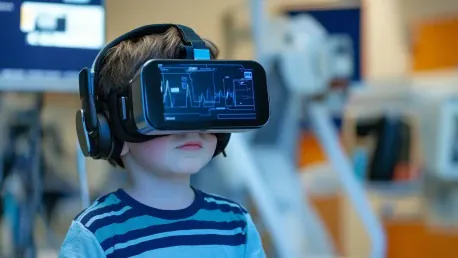Attention deficit/hyperactivity disorder (ADHD) is one of the most prevalent disorders in children, characterized by difficulties in maintaining focus, impulsiveness, and hyperactivity. Traditional diagnostic methods often struggle to quantify these symptoms accurately. Researchers at the University of Rhode Island have embarked on an innovative study to address this challenge by using wearable technology and computerized puzzles to identify ADHD patterns in children.
The Role of Wearable Technology
Smartwatches for Continuous Monitoring
The study involves children aged 6 to 11, both diagnosed with ADHD and non-ADHD subjects, wearing smartwatches on both hands. These devices collect data on behaviors such as fidgeting, finger-tapping, and hair-twirling. Given that many ADHD symptoms manifest subconsciously, the wearables provide invaluable insights into the frequency and nature of these behaviors. The collected data offers a unique perspective, allowing researchers to observe subtle and often unnoticed actions that may be indicative of ADHD. The continuous monitoring aspect ensures that these behaviors are logged in real-time, providing a more comprehensive picture of the child’s actions throughout various activities.
The application of smartwatches in this context differs significantly from traditional diagnostic methods, which often rely on self-reports, parental observations, or brief clinical assessments. By utilizing wearable technology, researchers can obtain objective data that paints a clearer and more accurate picture of each child’s behavior. This approach eliminates the biases and limitations inherent in subjective observations, enabling a more precise identification of ADHD-specific actions. Furthermore, the non-invasive nature of smartwatches makes this method less disruptive and more comfortable for children, ensuring higher cooperation and compliance during the study.
Objective Data Collection
Smartwatches offer a non-invasive way to gather consistent and objective data, marking a stark contrast with traditional diagnostic techniques which often rely heavily on subjective observations and self-reports from affected individuals or their guardians. By continuously monitoring movements, the researchers aim to distinguish ADHD behaviors from those of non-ADHD children, providing a more accurate diagnosis. This methodical approach ensures that data is collected across a range of scenarios, capturing natural behavior in everyday settings that are not typically observed in clinical environments.
The precision and reliability of smartwatch data collection are pivotal in understanding the nuances of ADHD symptoms. For instance, the device can track slight variations in fidgeting or finger-tapping frequencies that might go unnoticed during short clinical visits. This granular level of data facilitates a deeper understanding of how ADHD manifests in different activities, contributing to more tailored and effective intervention strategies. Moreover, the continuous data stream can help identify patterns over time, such as variations in behavior linked to different times of the day or specific tasks, thereby aiding in developing personalized management plans for affected children.
Computerized Puzzle Games
Tracking Mouse Movements
In addition to smartwatches, the study incorporates a computerized puzzle game that tracks mouse movements. The researchers focus on how children interact with the puzzle, noting differences in mouse movement patterns between ADHD and non-ADHD users. Non-ADHD users generally exhibit straightforward movements, while ADHD users display more erratic, complex movements before accurately positioning the pieces. This distinctive pattern of interaction provides crucial insights into the cognitive processes underlying ADHD, emphasizing the importance of detailed behavioral analysis in diagnosis.
The computerized puzzle game serves as a simulated environment where children can engage in problem-solving tasks while their behaviors are meticulously recorded. These tasks are designed to replicate real-world scenarios where attention and focus are required, hence providing a practical measure of a child’s ability to manage these skills. The erratic mouse movements observed in children with ADHD may reflect impulse control challenges and difficulties in maintaining consistent attention. By analyzing these movements, researchers can glean valuable information on the severity and specific characteristics of ADHD in each child, thus facilitating more nuanced diagnostic criteria.
Dual Monitoring Approach
Combining data from the smartwatch and mouse provides a comprehensive view of the participants’ actions. The smartwatch records movements when children take their hands off the mouse, ensuring continuous data collection. This dual monitoring approach enhances the accuracy of ADHD diagnosis and helps assess the disorder’s severity. The synergy between the two devices allows for a multifaceted analysis, capturing both the broad movements tracked by the smartwatch and the fine motor skills reflected in mouse interactions.
This comprehensive data collection strategy helps researchers construct a detailed behavioral profile for each participant. The smartwatch captures involuntary behaviors often linked to hyperactivity, while the computer mouse tracks focused interactions during cognitive tasks. Together, these data points offer a rich dataset from which patterns and correlations can be drawn. These insights enable a more precise differentiation between ADHD-specific behaviors and those that are generally characteristic of non-ADHD children. Furthermore, the dual monitoring approach holds promise for developing more effective personalized interventions by accurately mapping out the various dimensions of ADHD symptoms.
Impact of Task Difficulty on Focus
Hyper-Focus on Challenging Tasks
The study reveals that children with ADHD become hyper-focused on tasks that are challenging and under time constraints. This finding highlights the importance of task difficulty in maintaining engagement and focus among ADHD-diagnosed students. By adjusting task difficulty, researchers were able to determine the optimal level of challenge required to capture and hold the attention of children with ADHD. This discovery points to the potential of tailored educational strategies that can significantly enhance learning experiences for these students by leveraging their propensity for hyper-focus on appropriately challenging tasks.
Understanding the relationship between task difficulty and engagement is crucial for developing effective learning environments for children with ADHD. Teachers and parents could use these insights to create more engaging and challenging activities that keep ADHD children motivated and focused. Crucially, the study’s findings suggest that the conventional approach of simplifying tasks for ADHD students might be counterproductive. Instead, providing engaging, challenging, yet manageable tasks may yield better educational outcomes and help maintain sustained attention. This approach emphasizes the need to rethink traditional educational methodologies to better accommodate the unique cognitive profiles of ADHD students.
Disengagement from Easy Tasks
Conversely, the researchers observe that children with ADHD lose interest and disengage when tasks are too easy and quick to complete. The designed game engine adjusts puzzle difficulty to maintain engagement, demonstrating that optimal challenge levels are crucial for sustaining attention in ADHD-diagnosed students. This adjustment mechanism enabled researchers to maintain a consistent level of engagement, effectively illustrating the critical balance between task simplicity and complexity in managing ADHD symptoms.
The finding underscores the potential pitfalls of under-challenging ADHD students, which can lead to disengagement and exacerbation of symptoms. It indicates that maintaining an optimal difficulty level is not only about keeping the student engaged but also about preventing the frustration and boredom that can lead to further behavioral issues. Such insights could be invaluable in reforming educational approaches and developing new ADHD-focused curricular frameworks that promote sustained engagement. Customizing task difficulty based on individual response patterns could revolutionize the way ADHD is managed in educational settings, ultimately improving both behavioral and academic outcomes for affected students.
Subconscious Behaviors and Diagnostic Nuances
Non-Dominant Hand Movements
A particularly interesting observation is the subconscious behaviors displayed by non-dominant hands during primary tasks. While the dominant hand is engaged in solving the puzzle, the non-dominant hand exhibits other behaviors, often unnoticed by the users. This finding emphasizes the complexity of ADHD symptoms and supports the need for nuanced diagnostic methods. Tracking these subtle, subconscious actions provides a richer understanding of the behavioral spectrum associated with ADHD, highlighting actions that might not be captured through conventional observation methods.
These involuntary behaviors, such as spontaneous movements or minor fidgeting, potentially offer deeper insights into the neurological underpinnings of ADHD. The fact that these actions occur without conscious awareness demonstrates that ADHD affects motor control on more levels than previously understood. Acknowledging and analyzing these subconscious behaviors could lead to more comprehensive diagnostic criteria that encompass both overt and subtle manifestations of the disorder. This approach further validates the use of technology-based monitoring in capturing the full range of ADHD symptoms, offering a more detailed and accurate diagnostic process.
Comprehensive Behavioral Data
The study consolidates its findings into a coherent narrative, demonstrating that nuanced behavioral data collected through smartwatches and puzzles can effectively differentiate ADHD symptoms from typical behaviors. These methods could revolutionize the detection and management of ADHD, providing an accurate, user-friendly approach. By combining various data points, researchers can create a multidimensional profile for each child, identifying specific patterns and behaviors associated with ADHD. This comprehensive data analysis marks a significant advancement in the field, suggesting that technology can offer superior precision and reliability compared to traditional diagnostic practices.
In summary, the study sheds light on the vast potential of wearable technology and computerized tasks in diagnosing ADHD, providing actionable insights for future research and clinical applications. The objective, continuous data collection facilitates early detection, enabling timely interventions that can improve long-term outcomes for children with ADHD. Moreover, these findings highlight the importance of innovative diagnostic tools, demonstrating that a nuanced understanding of behavioral patterns is key to addressing the complexities of ADHD. As these methods become more refined and widely adopted, they hold the promise of transforming ADHD management and providing tailored support to those affected by this disorder.
Future Implications and Expansion
Practical Diagnostic Tools
An overarching trend in the study is the pursuit of accessible, accurate diagnostic tools to identify ADHD in everyday settings, such as classrooms or homes. This approach could facilitate early intervention and tailored educational strategies, improving outcomes for children with ADHD. By integrating wearable technology into everyday environments, diagnoses can be made more naturally and continuously, capturing the child’s behavior in familiar contexts. This accessibility presents significant advantages, reducing the need for clinical visits and making diagnostic tools more readily available to families and educators.
Moreover, such practical diagnostic tools could have far-reaching implications, from streamlining the diagnostic process to implementing daily monitoring strategies that help manage symptoms more effectively. They can provide real-time feedback and support, helping teachers and parents promptly address emerging concerns. The convenience and efficiency of these tools could lead to more proactive management of ADHD, ensuring that children receive the support they need as early as possible. By embedding diagnostic capabilities in routine settings, this innovative approach could democratize access to ADHD diagnostics, promoting better mental health outcomes across diverse populations.
Expanding the Study
Attention deficit/hyperactivity disorder (ADHD) is a common disorder in children and involves difficulties in staying focused, controlling impulses, and exhibiting hyperactive behaviors. Diagnosing ADHD can be challenging because traditional methods often fail to measure these symptoms accurately. To tackle this issue, researchers at the University of Rhode Island have initiated a groundbreaking study. They are utilizing wearable technology combined with computerized puzzles to discern ADHD patterns in kids. This innovative approach aims to provide a more accurate and quantifiable method for diagnosing ADHD, potentially offering more effective treatment for those affected by the disorder. By integrating modern technology with diagnostic techniques, the researchers hope to gain deeper insights into how ADHD manifests in children and improve clinical practices. These advancements could lead to better intervention strategies, ultimately enhancing the quality of life for children living with ADHD and supporting their development more effectively.









